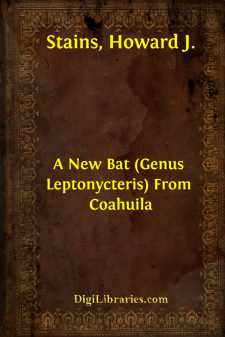Categories
- Antiques & Collectibles 13
- Architecture 36
- Art 48
- Bibles 22
- Biography & Autobiography 813
- Body, Mind & Spirit 142
- Business & Economics 28
- Children's Books 15
- Children's Fiction 12
- Computers 4
- Cooking 94
- Crafts & Hobbies 4
- Drama 346
- Education 46
- Family & Relationships 57
- Fiction 11828
- Games 19
- Gardening 17
- Health & Fitness 34
- History 1377
- House & Home 1
- Humor 147
- Juvenile Fiction 1873
- Juvenile Nonfiction 202
- Language Arts & Disciplines 88
- Law 16
- Literary Collections 686
- Literary Criticism 179
- Mathematics 13
- Medical 41
- Music 40
- Nature 179
- Non-Classifiable 1768
- Performing Arts 7
- Periodicals 1453
- Philosophy 64
- Photography 2
- Poetry 896
- Political Science 203
- Psychology 42
- Reference 154
- Religion 513
- Science 126
- Self-Help 84
- Social Science 81
- Sports & Recreation 34
- Study Aids 3
- Technology & Engineering 59
- Transportation 23
- Travel 463
- True Crime 29
A New Bat (Genus Leptonycteris) From Coahuila
by: Howard J. Stains
Description:
Excerpt
In a collection of mammals obtained in Coahuila, México, there is a series of 24 long-nosed bats, Leptonycteris nivalis. These bats have a larger skull and a longer third finger than other bats of this species found to the south of Coahuila. On the basis of these distinctive characters, it seems appropriate to recognize these long-nosed bats from Coahuila as belonging to a new subspecies, named and described as follows:
new subspecies
Type.—Female, adult, skin and skull, No. 33087, Univ. Kansas Mus. Nat. Hist.; 12 mi. S and 2 mi. E Arteaga, 7500 ft., Coahuila; 11 July 1949; obtained by W. K. Clark, original number 787.
Range.—Southern Coahuila north to the Big Bend (Brewster County) of Texas.
Diagnosis.—Size large (see measurements); third finger long; color pale, upperparts Hair Brown (capitalized color terms are after Ridgway, Color Standards and Color Nomenclature, Washington, D. C., 1912), underparts Smoke Gray; skull large and broad.
Comparisons.—From Leptonycteris nivalis nivalis (specimens from Veracruz, Oaxaca, Distrito Federal, Hidalgo, Jalisco, and Sonora), L. n. longala differs as follows: color paler, more whitish and less brownish; third finger longer (longala from Coahuila averaging 111.3 mm.; nivalis from Sonora averaging 91.0, from Jalisco 96.4, from Hidalgo 98.0, from Veracruz 100.0, from Distrito Federal 100.2, and from Oaxaca 98.6); skull larger, breadth of cranium greater (longala from Coahuila averaging 10.7 mm.; nivalis from Sonora 9.8, from Jalisco 9.8, from Hidalgo 9.6, from Veracruz 9.9, from Distrito Federal 9.9, and from Oaxaca 9.8); mastoidal breadth greater (longala from Coahuila averaging 11.6 mm.; nivalis from Sonora 10.5, from Jalisco 10.8, from Hidalgo 10.6, from Veracruz 10.9, from Distrito Federal 10.8, and from Oaxaca 10.7); skull higher (longala from Coahuila averaging 10.0 mm.; nivalis from Sonora 9.3, from Jalisco 9.2, from Hidalgo 9.2, from Veracruz 9.3, from Distrito Federal 9.3, and from Oaxaca 9.1). The average of each dimension of longala listed above exceeds the maximum of the corresponding dimension in nivalis.
Remarks.—Leptonycteris nivalis longala inhabits the northeastern end of the Mexican Plateau. Bats from Brewster County, Texas, referred to longala, average slightly larger in all measurements taken than do specimens from southern Coahuila. Specimens from Cerro PotosÃ, Municipio de Galeana, Nuevo León, also are referred to longala on the basis of the length of their third fingers. Like the specimens from Texas, these bats possess longer forearms, on the average, than do bats from Coahuila.
Topotypes of L. n. nivalis from Mount Orizaba were not available, but 111 specimens referable to the subspecies nivalis were examined. These specimens were from the following places: Sonora: ¼ mi. W Aduana, 1600 ft., 4 specimens. Jalisco: Hda. San MartÃn, 5000 ft., 18 mi. W Chapala, 3; 11 mi. W Chapala, 5000 ft., 1; 5 mi. W Chapala, 5000 ft., 58; 8 mi. NE Ocotlán, 5100 ft., 1. Hidalgo: 6 km. NW Tasquillo, 500 ft., 1. Veracruz: 3 km. W Boca del RÃo, 25 ft., 22. Distrito Federal: Chicomostoc, Cerro Teutli, 2ââ¦â mi. NNW Milpa Alta, 2620 ft., 18. Oaxaca: Cuicatlán, 600 ft., 1; 3 km. WNW Dominguillo, 730 ft., 2. All these specimens are in the Museum of Natural History at the University of Kansas. Little discernible geographic variation was found in these specimens of L. n. nivalis. No specimens could, with certainty, be classed as intergrades between longala and nivalis, but it is thought that intergrades will be found in western San Luis Potosà or in Zacatecas or in both states....


